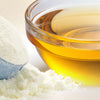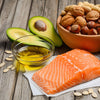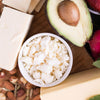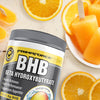How Does Our PrimaForce KetoShake Stack Up Against High-Protein Shakes?


Consumption of convenience foods has been on the rise for decades1, with more and more Americans embracing an alternative to hours spent in the kitchen. Sure, everybody loves good home-cooked meals, but simply can’t fit them into their schedules every day. Instead, restaurants and manufacturers stepped in to offer drive-thrus, heat-and-eat meals, and other grab-and-go fares. It didn’t take long for these quick eats to be implicated as major contributors to society’s growing waistlines and climbing rates of metabolic disease. With pressure from consumers’ increasing concern (obsession?) with health, food companies turned their attention to making more nutritious products that were still quick and tasty.
Enter, the “healthy shake.”
Whether it comes in a carton, a can, or as a powder that you blend into liquid, meal replacement drinks (MRP) have evolved as a staple in the health and wellness sphere. Not only are these shakes a market success, but they also appear to be pretty effective aids to certain health goals. A meta-analysis of six different studies found that individuals swapping out one meal a day with a liquid MRP achieved and maintained health improvements better than those following a calorically-equivalent regular-food diet.2 Simply put, MRPs help us stick to our nutrition goals by offering a ready-to-consume food when we may otherwise grab a bag of chips, candy bar, or skip eating altogether. However, a glaring caveat exists when considering the contents and quality of various shakes – not all MRPs are created equal.
Problems arise when simply comparing a product’s calorie count, or falling victim to common macro nutrient myths (i.e. the fat-free craze of the ’80s). What’s actually in that MRP shake makes a huge difference. The energy you’re getting, or not getting, from a bar or a shake ultimately boils down to the amount of carbs, protein, and fat contained inside. We can turn any of those three macro nutrients into usable biochemical fuel, known as ATP. However, the body’s physiological response to each macronutrient is very different, and this has important implications for how satiated, energized and focused we feel after consuming a meal or a snack.3
Sure, the quality of ingredients definitely matters as well, which is why PrimaForce KetoShakes contain well-sourced oils, grass-fed whey, and no artificial sweeteners, coloring, or flavors. Even when simply looking through a metabolic lens, it’s clear that the macro profile of PrimaForce KetoShakes stack up against competitors to help you fuel your best.
A protein-packed shake tops anything too sugary or carb-heavy. Protein provides the crucial amino acids, known as the “building blocks” of protein, that we need for a host of physiological processes like muscle growth and repair. However, excess protein can actually work against someone trying to make the keto switch. Our bodies have the ability to turn certain amino acids into glucose through a metabolic process known as gluconeogenesis,4 meaning those extra grams of protein can end up just like carbohydrates and thwart your efforts to reach ketosis. This is why the ketogenic lifestyle embraces a Goldilocks approach to protein – not too little, not too much. We’ve formulated PrimaForce KetoShakes to provide an optimal 7 grams of grass-fed whey protein in every serving, enough to preserve muscle without compromising a ketogenic state.
PrimaForce KetoShakes vs. High-Protein Shakes
| PrimaForce KetoShake | Primal Fuel | Muscle Milk | Premier Protein | Vega One Shake | Core Nutritionals MRP | |
|---|---|---|---|---|---|---|
 |
 |
 |
 |
 |
 |
|
| Calories | 160 | 190 | 320 | 180 | 160 | 245 |
| Fat | 13 | 9 | 14 | 3.5 | 6 | 3 |
| Carbs | 6 | 9 | 13 | 8 | 9 | 27 |
| Fiber | 2 | 3 | 1 | 2 | 6 | 5 |
| Protein | 7 | 20 | 34 | 30 | 20 | 27 |
| <200 calories per serving | X | X | X | X | ||
| <5 Net carbs | X | X | ||||
| Grass-fed whey | X | |||||
| No artificial flavors/colors | X | X | X | X |
REFERENCES
- Okrent AM, Kumcu A. U.S. Households’ Demand for Convenience Foods. 2016. https://www.ers.usda.gov/webdocs/publications/80654/err-211.pdf?v=42668. Accessed July 20, 2017.
- Heymsfield SB, van Mierlo CAJ, van der Knaap HCM, Heo M, Frier HI. Weight management using a meal replacement strategy: meta and pooling analysis from six studies. Int J Obes. 2003;27(5):537-549. doi:10.1038/sj.ijo.0802258.
- Lloyd HM, Green MW, Rogers PJ. Mood and cognitive performance effects of isocaloric lunches differing in fat and carbohydrate content. Physiol Behav. 1994;56(1):51-57. http://www.ncbi.nlm.nih.gov/pubmed/8084907. Accessed July 23, 2017.
- Schutz Y. Protein Turnover, Ureagenesis and Gluconeogenesis. Int J Vitam Nutr Res. 2011;81(23):101-107. doi:10.1024/0300-9831/a000064.




